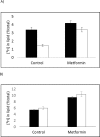Metformin Decouples Phospholipid Metabolism in Breast Cancer Cells
- PMID: 26959405
- PMCID: PMC4784930
- DOI: 10.1371/journal.pone.0151179
Metformin Decouples Phospholipid Metabolism in Breast Cancer Cells
Abstract
Introduction: The antidiabetic drug metformin, currently undergoing trials for cancer treatment, modulates lipid and glucose metabolism both crucial in phospholipid synthesis. Here the effect of treatment of breast tumour cells with metformin on phosphatidylcholine (PtdCho) metabolism which plays a key role in membrane synthesis and intracellular signalling has been examined.
Methods: MDA-MB-468, BT474 and SKBr3 breast cancer cell lines were treated with metformin and [3H-methyl]choline and [14C(U)]glucose incorporation and lipid accumulation determined in the presence and absence of lipase inhibitors. Activities of choline kinase (CK), CTP:phosphocholine cytidylyl transferase (CCT) and PtdCho-phospholipase C (PLC) were also measured. [3H] Radiolabelled metabolites were determined using thin layer chromatography.
Results: Metformin-treated cells exhibited decreased formation of [3H]phosphocholine but increased accumulation of [3H]choline by PtdCho. CK and PLC activities were decreased and CCT activity increased by metformin-treatment. [14C] incorporation into fatty acids was decreased and into glycerol was increased in breast cancer cells treated with metformin incubated with [14C(U)]glucose.
Conclusion: This is the first study to show that treatment of breast cancer cells with metformin induces profound changes in phospholipid metabolism.
Conflict of interest statement
Figures








Similar articles
-
Alterations of phospholipid metabolism by phorbol esters and fatty acids occur by different intracellular mechanisms in cultured glioma, neuroblastoma, and hybrid cells.J Biol Chem. 1989 Feb 15;264(5):2746-52. J Biol Chem. 1989. PMID: 2914928
-
Choline kinase-α protein and phosphatidylcholine but not phosphocholine are required for breast cancer cell survival.NMR Biomed. 2015 Dec;28(12):1697-706. doi: 10.1002/nbm.3429. Epub 2015 Oct 27. NMR Biomed. 2015. PMID: 26503172
-
Enhancement of free fatty acid incorporation into phospholipids by choline plus cytidine.Brain Res. 1999 Mar 20;822(1-2):52-9. doi: 10.1016/s0006-8993(99)01072-0. Brain Res. 1999. PMID: 10082883
-
CDP-choline significantly restores phosphatidylcholine levels by differentially affecting phospholipase A2 and CTP: phosphocholine cytidylyltransferase after stroke.J Biol Chem. 2006 Mar 10;281(10):6718-25. doi: 10.1074/jbc.M512112200. Epub 2005 Dec 27. J Biol Chem. 2006. Retraction in: J Biol Chem. 2013 Mar 15;288(11):7549. doi: 10.1074/jbc.A113.512112. PMID: 16380371 Retracted.
-
Phosphatidylcholine and the CDP-choline cycle.Biochim Biophys Acta. 2013 Mar;1831(3):523-32. doi: 10.1016/j.bbalip.2012.09.009. Epub 2012 Sep 23. Biochim Biophys Acta. 2013. PMID: 23010477 Free PMC article. Review.
Cited by
-
Metformin Accumulation Correlates with Organic Cation Transporter 2 Protein Expression and Predicts Mammary Tumor Regression In Vivo.Cancer Prev Res (Phila). 2017 Mar;10(3):198-207. doi: 10.1158/1940-6207.CAPR-16-0211-T. Epub 2017 Feb 2. Cancer Prev Res (Phila). 2017. PMID: 28154203 Free PMC article.
-
Metformin Reduces Lipotoxicity-Induced Meta-Inflammation in β-Cells through the Activation of GPR40-PLC-IP3 Pathway.J Diabetes Res. 2019 Dec 18;2019:7602427. doi: 10.1155/2019/7602427. eCollection 2019. J Diabetes Res. 2019. PMID: 31950065 Free PMC article.
-
Probing the PI3K/Akt/mTor pathway using 31P-NMR spectroscopy: routes to glycogen synthase kinase 3.Sci Rep. 2016 Nov 4;6:36544. doi: 10.1038/srep36544. Sci Rep. 2016. PMID: 27811956 Free PMC article.
-
Divergent Metabolic Effects of Metformin Merge to Enhance Eicosapentaenoic Acid Metabolism and Inhibit Ovarian Cancer In Vivo.Cancers (Basel). 2022 Mar 15;14(6):1504. doi: 10.3390/cancers14061504. Cancers (Basel). 2022. PMID: 35326656 Free PMC article.
-
Response Detection of Castrate-Resistant Prostate Cancer to Clinically Utilised and Novel Treatments by Monitoring Phospholipid Metabolism.Biomed Res Int. 2017;2017:4793465. doi: 10.1155/2017/4793465. Epub 2017 Jun 22. Biomed Res Int. 2017. PMID: 28717648 Free PMC article.
References
-
- Cui Z, Houweling M. Phosphatidylcholine and cell death. Biochim Biophys Acta 2002; 1585(2–3): 87–96. - PubMed
-
- Podo F, Saradanelli F, Iorio E, Canese R, Carpinelli G, Fausto A, et al. Abnormal Choline Phospholipid Metabolism in Breast and Ovary Cancer: Molecular Bases for Noninvasive Imaging Approaches. Current Medical Imaging Reviews 2007; 3(2): 123–137
Publication types
MeSH terms
Substances
LinkOut - more resources
Full Text Sources
Other Literature Sources
Medical
Research Materials
Miscellaneous

